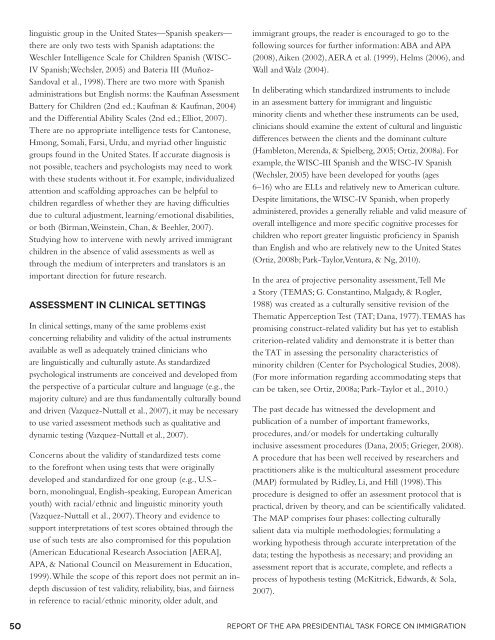Crossroads: The Psychology of Immigration in the New Century
Crossroads: The Psychology of Immigration in the New Century
Crossroads: The Psychology of Immigration in the New Century
Create successful ePaper yourself
Turn your PDF publications into a flip-book with our unique Google optimized e-Paper software.
l<strong>in</strong>guistic group <strong>in</strong> <strong>the</strong> United States—Spanish speakers—<br />
<strong>the</strong>re are only two tests with Spanish adaptations: <strong>the</strong><br />
Weschler Intelligence Scale for Children Spanish (WISC-<br />
IV Spanish; Wechsler, 2005) and Bateria III (Muñoz-<br />
Sandoval et al., 1998). <strong>The</strong>re are two more with Spanish<br />
adm<strong>in</strong>istrations but English norms: <strong>the</strong> Kaufman Assessment<br />
Battery for Children (2nd ed.; Kaufman & Kaufman, 2004)<br />
and <strong>the</strong> Differential Ability Scales (2nd ed.; Elliot, 2007).<br />
<strong>The</strong>re are no appropriate <strong>in</strong>telligence tests for Cantonese,<br />
Hmong, Somali, Farsi, Urdu, and myriad o<strong>the</strong>r l<strong>in</strong>guistic<br />
groups found <strong>in</strong> <strong>the</strong> United States. If accurate diagnosis is<br />
not possible, teachers and psychologists may need to work<br />
with <strong>the</strong>se students without it. For example, <strong>in</strong>dividualized<br />
attention and scaffold<strong>in</strong>g approaches can be helpful to<br />
children regardless <strong>of</strong> whe<strong>the</strong>r <strong>the</strong>y are hav<strong>in</strong>g difficulties<br />
due to cultural adjustment, learn<strong>in</strong>g/emotional disabilities,<br />
or both (Birman, We<strong>in</strong>ste<strong>in</strong>, Chan, & Beehler, 2007).<br />
Study<strong>in</strong>g how to <strong>in</strong>tervene with newly arrived immigrant<br />
children <strong>in</strong> <strong>the</strong> absence <strong>of</strong> valid assessments as well as<br />
through <strong>the</strong> medium <strong>of</strong> <strong>in</strong>terpreters and translators is an<br />
important direction for future research.<br />
assessment <strong>in</strong> Cl<strong>in</strong>ical sett<strong>in</strong>gs<br />
In cl<strong>in</strong>ical sett<strong>in</strong>gs, many <strong>of</strong> <strong>the</strong> same problems exist<br />
concern<strong>in</strong>g reliability and validity <strong>of</strong> <strong>the</strong> actual <strong>in</strong>struments<br />
available as well as adequately tra<strong>in</strong>ed cl<strong>in</strong>icians who<br />
are l<strong>in</strong>guistically and culturally astute. As standardized<br />
psychological <strong>in</strong>struments are conceived and developed from<br />
<strong>the</strong> perspective <strong>of</strong> a particular culture and language (e.g., <strong>the</strong><br />
majority culture) and are thus fundamentally culturally bound<br />
and driven (Vazquez-Nuttall et al., 2007), it may be necessary<br />
to use varied assessment methods such as qualitative and<br />
dynamic test<strong>in</strong>g (Vazquez-Nuttall et al., 2007).<br />
Concerns about <strong>the</strong> validity <strong>of</strong> standardized tests come<br />
to <strong>the</strong> forefront when us<strong>in</strong>g tests that were orig<strong>in</strong>ally<br />
developed and standardized for one group (e.g., U.S.born,<br />
monol<strong>in</strong>gual, English-speak<strong>in</strong>g, European American<br />
youth) with racial/ethnic and l<strong>in</strong>guistic m<strong>in</strong>ority youth<br />
(Vazquez-Nuttall et al., 2007). <strong>The</strong>ory and evidence to<br />
support <strong>in</strong>terpretations <strong>of</strong> test scores obta<strong>in</strong>ed through <strong>the</strong><br />
use <strong>of</strong> such tests are also compromised for this population<br />
(American Educational Research Association [AERA],<br />
APA, & National Council on Measurement <strong>in</strong> Education,<br />
1999). While <strong>the</strong> scope <strong>of</strong> this report does not permit an <strong>in</strong>depth<br />
discussion <strong>of</strong> test validity, reliability, bias, and fairness<br />
<strong>in</strong> reference to racial/ethnic m<strong>in</strong>ority, older adult, and<br />
immigrant groups, <strong>the</strong> reader is encouraged to go to <strong>the</strong><br />
follow<strong>in</strong>g sources for fur<strong>the</strong>r <strong>in</strong>formation: ABA and APA<br />
(2008), Aiken (2002), AERA et al. (1999), Helms (2006), and<br />
Wall and Walz (2004).<br />
In deliberat<strong>in</strong>g which standardized <strong>in</strong>struments to <strong>in</strong>clude<br />
<strong>in</strong> an assessment battery for immigrant and l<strong>in</strong>guistic<br />
m<strong>in</strong>ority clients and whe<strong>the</strong>r <strong>the</strong>se <strong>in</strong>struments can be used,<br />
cl<strong>in</strong>icians should exam<strong>in</strong>e <strong>the</strong> extent <strong>of</strong> cultural and l<strong>in</strong>guistic<br />
differences between <strong>the</strong> clients and <strong>the</strong> dom<strong>in</strong>ant culture<br />
(Hambleton, Merenda, & Spielberg, 2005; Ortiz, 2008a). For<br />
example, <strong>the</strong> WISC-III Spanish and <strong>the</strong> WISC-IV Spanish<br />
(Wechsler, 2005) have been developed for youths (ages<br />
6–16) who are ELLs and relatively new to American culture.<br />
Despite limitations, <strong>the</strong> WISC-IV Spanish, when properly<br />
adm<strong>in</strong>istered, provides a generally reliable and valid measure <strong>of</strong><br />
overall <strong>in</strong>telligence and more specific cognitive processes for<br />
children who report greater l<strong>in</strong>guistic pr<strong>of</strong>iciency <strong>in</strong> Spanish<br />
than English and who are relatively new to <strong>the</strong> United States<br />
(Ortiz, 2008b; Park-Taylor, Ventura, & Ng, 2010).<br />
In <strong>the</strong> area <strong>of</strong> projective personality assessment, Tell Me<br />
a Story (TEMAS; G. Constant<strong>in</strong>o, Malgady, & Rogler,<br />
1988) was created as a culturally sensitive revision <strong>of</strong> <strong>the</strong><br />
<strong>The</strong>matic Apperception Test (TAT; Dana, 1977). TEMAS has<br />
promis<strong>in</strong>g construct-related validity but has yet to establish<br />
criterion-related validity and demonstrate it is better than<br />
<strong>the</strong> TAT <strong>in</strong> assess<strong>in</strong>g <strong>the</strong> personality characteristics <strong>of</strong><br />
m<strong>in</strong>ority children (Center for Psychological Studies, 2008).<br />
(For more <strong>in</strong>formation regard<strong>in</strong>g accommodat<strong>in</strong>g steps that<br />
can be taken, see Ortiz, 2008a; Park-Taylor et al., 2010.)<br />
<strong>The</strong> past decade has witnessed <strong>the</strong> development and<br />
publication <strong>of</strong> a number <strong>of</strong> important frameworks,<br />
procedures, and/or models for undertak<strong>in</strong>g culturally<br />
<strong>in</strong>clusive assessment procedures (Dana, 2005; Grieger, 2008).<br />
A procedure that has been well received by researchers and<br />
practitioners alike is <strong>the</strong> multicultural assessment procedure<br />
(MAP) formulated by Ridley, Li, and Hill (1998). This<br />
procedure is designed to <strong>of</strong>fer an assessment protocol that is<br />
practical, driven by <strong>the</strong>ory, and can be scientifically validated.<br />
<strong>The</strong> MAP comprises four phases: collect<strong>in</strong>g culturally<br />
salient data via multiple methodologies; formulat<strong>in</strong>g a<br />
work<strong>in</strong>g hypo<strong>the</strong>sis through accurate <strong>in</strong>terpretation <strong>of</strong> <strong>the</strong><br />
data; test<strong>in</strong>g <strong>the</strong> hypo<strong>the</strong>sis as necessary; and provid<strong>in</strong>g an<br />
assessment report that is accurate, complete, and reflects a<br />
process <strong>of</strong> hypo<strong>the</strong>sis test<strong>in</strong>g (McKitrick, Edwards, & Sola,<br />
2007).<br />
50 Report <strong>of</strong> <strong>the</strong> APA Presidential Task Force on <strong>Immigration</strong>
















